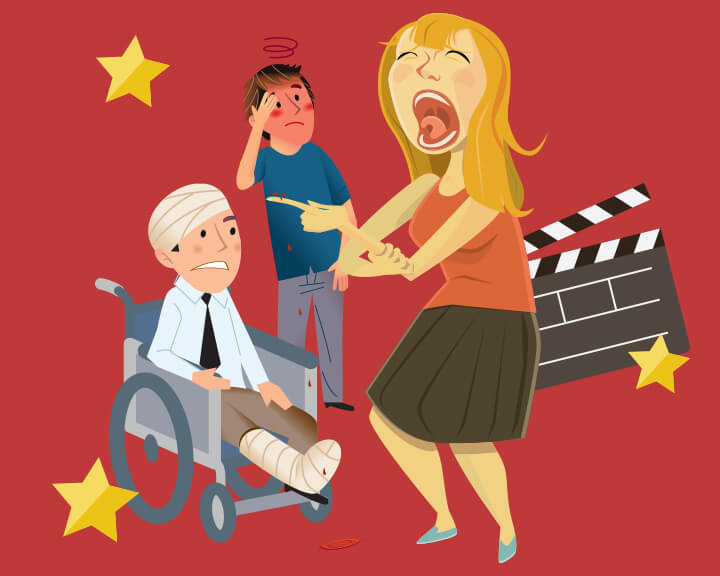For several years, Shenandoah University’s Division of Physician Assistant (PA) Studies has collaborated with Shenandoah Conservatory acting students to provide graduate students with the means to enhance their learning through simulation exercises. Interprofessional case learning is a critical component of today’s health education, and learning in small groups helps PA students to practice what they are learning as they react to various types of simulated patients.
“Simulation in the form of standardized patients provides an opportunity for students to engage in real-life experiences while they’re in the formative stages of their learning,” said Director and Associate Professor of Physician Assistant Studies Rachel Carlson, Ed.D. “It provides depth and breadth and gives them the opportunity to learn how to gather information from patients. I think it also helps student actors as they practice their craft.”
CASE STUDY APPROACH TO SIMULATION
Physician assistant students approach simulation using a small-group case study approach, where the professor serves as an observer and facilitator. Each student brings his or her strengths and weaknesses to the scenario, and each is assigned a role to play.
“The hardest part as a facilitator is to remain quiet, but that’s our job,” Carlson emphasized. “We ask probing questions and let them talk themselves through the process.”
In simulation, PA students conduct the interviews and ask questions, interacting with their student counterparts who serve as standardized patients. The actors follow a script describing patient names and ages; medical, social and family history; and symptoms and medication. From there, they have to develop their characters and play the roles required for the exercise.
Each case is delivered through Blackboard, and each PA student is assigned a specific leadership role. They use their laptops to view the case; take and share notes; look up information in electronic library resources or search Google for terms and descriptions.
Each student takes a turn interviewing the standardized patient (i.e., acting student), while the others observe and take notes. Then each one returns to the small group to discuss what worked or didn’t work and to fill in the gaps of information needed as they work collectively through the case.
“We know, and the evidence has shown, that when students learn on their own and together, they retain the information better,” said Carlson. “When they come across problems or need to puzzle through the answers required for a particular symptom, they spend time in the literature, asking the right questions and gathering the information they need to make good diagnostic decisions.”
With each case scenario, students gain more confidence in themselves as well as in their ability to ask the right questions. They learn to address the issues related to the case as they interact with the simulated patients.
“It’s really impressive for us to see the growth that occurs from these sessions,” said Carlson. “They enter the program as individuals who know very little about medicine, and then they turn into clinicians, right before our eyes.”
‘PRACTICING’ WITH STANDARDIZED PATIENTS
“Working with the standardized patients is a good experience,” said first-year PA student Kaitlyn Robinson. “It’s the most real-life experience we can get in the classroom. You never know what you’re going to run into, and it lets us practice in a variety of situations.”
Robinson said the simulation exercise helped reveal some things she needs to work on as a provider.
“I had never worked with multiple patients at once,” said Robinson. “The ‘family member’ I interviewed was giving me lots of data, but the patient who needed the medication didn’t offer much feedback at all,” she said. “That was difficult, because they were bickering back forth, and it was hard to get them to focus on the what I needed to know.”
It’s also an exercise, she said, that requires some imagination.
“We’re not actors, we’re PA students,” said said. “So, in simulation, you have to remember that while you’re looking at a 20 year-old college student, she represents a 49 year-old, obese woman with diabetes. You have to look beyond this young, fit person and envision who this person represents.”
“We’re used to practicing on one another,” explained first-year PA student Amy Moorhead. “So there’s a level of comfort there, but it doesn’t feel very real. When we have someone in front of us that we don’t know, it’s a little more natural, like you’re actually with a patient. They give you a response and stay in character, and we don’t get that when we’re just working with each other.”
“Patients won’t know what you’re going to ask, and they sure aren’t going to know how to respond in medical terms,” said first-year PA student Walker Necessary. “So it was a great experience to talk to a ‘real’ patient, and to see how our skills are right now, and how we can improve them.”
According to Moorhead, it’s not the medical issue but the human factor that makes working with simulation patients so rewarding.
“Patients are so much more than their clinical signs and symptoms, and even though something may be very clear on paper, people aren’t simple. So, being able to connect with a person wherever they are seems to be the way to get a better health outcome.”
INTERPROFESSIONAL EDUCATION
The opportunity for PAs and actors to collaborate in an academic health care setting appears to be a win-win for both PA and acting students. In this second year of patient simulations conducted in small-group settings, collaboration between the School of Health Professions and Shenandoah Conservatory continues to evolve.
“There aren’t many schools of health professions within a university that are connected to a conservatory,” said Carlson. “This opportunity to cross disciplines is not something every institution can do.”
— Contributed by Cathy Loranger
